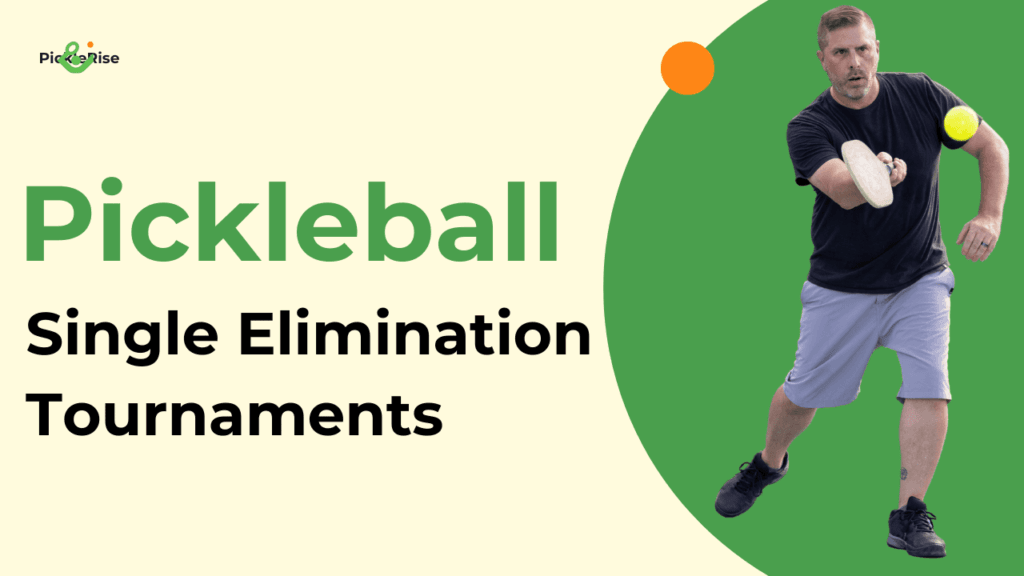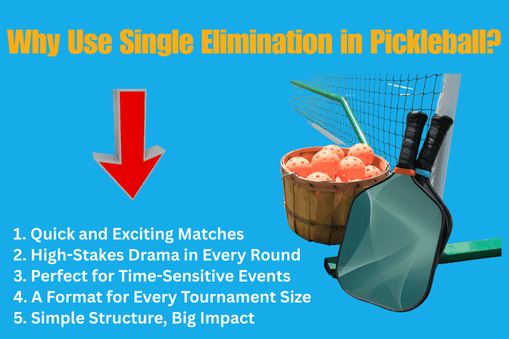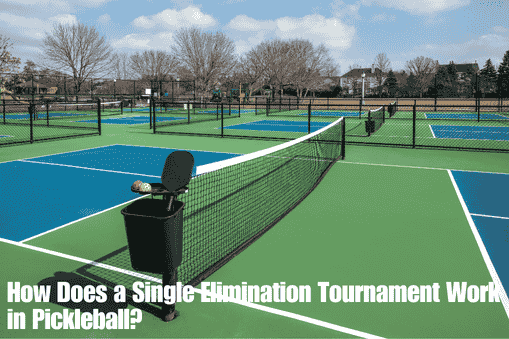No products in the cart.
Pickleball Single Elimination Tournaments :Pickleball Guide
A single-elimination tournament is a format where players or teams compete in a series of rounds, and the loser of each match is eliminated from the tournament. The process continues until only one player or team remains as the winner.
In this format, each match is a do-or-die situation, meaning if you lose, you are out. The excitement of this format comes from the fact that there are no second chances, making every match intense and high stakes.

Understanding tournament formats is crucial in sports, particularly in pickleball, as it directly impacts the strategy, preparation, and mindset of the players. In a sport like pickleball, where players need to be quick and strategic, knowing the structure of the tournament allows them to focus on performance in each round without being distracted by uncertainty.
What is a Pickleball Single Elimination Tournaments?
A Single Elimination Tournament (often called knockout or sudden death) is a type of competition where players or teams are eliminated after each loss. In this format, each match is crucial lose once, and you are out. The tournament continues until only one competitor remains, declared the winner. It’s a fast-paced, high-stakes structure that adds a layer of excitement, making every game matter more.
The format also influences the pacing and progression of the event, determining how long the competition lasts and how players adjust their play style. Understanding this format helps players and fans alike manage expectations and fully appreciate the intensity and excitement of each match.
How the Elimination Process Works?
In a single elimination tournament, competitors are paired up for the first round. The winner of each match moves on to the next round, while the loser is immediately eliminated from the competition. This process continues until there’s just one final match, and one last competitor standing as the winner. As each round passes, the number of competitors gets smaller, making each match more intense as it gets closer to the final showdown.
Differences from Other Tournament Formats
When compared to formats like round-robin or double elimination, single elimination is much more straightforward and quicker. In a round-robin format, every player competes against every other player, and the winner is determined by the total number of wins. This format takes longer, especially with a larger group of players.
1. Double elimination
In double elimination, competitors get a second chance. After their first loss, they are moved into a losers’ bracket and have the opportunity to continue fighting for the title. This gives players a bit of leeway, unlike single elimination, where one loss means immediate elimination.
2. Single elimination
Single elimination’s simplicity and the excitement of sudden death make it a thrilling choice for competitions where stakes are high, and there’s no room for mistakes. Every match is a crucial battle, with each loss pushing competitors one step closer to the exit.
3. Pool Play
Pool Play tournaments involve grouping players or teams into separate pools where they compete against every other team within their pool in a round-robin format.
Each team faces multiple opponents, ensuring a set number of matches regardless of performance outcomes.
After these preliminary matches, results are used to determine which teams qualify for subsequent knockout stages or playoffs.
Why Use Single Elimination in Pickleball?

The Single Elimination Tournament format is a popular choice in pickleball for several key reasons. It keeps the competition exciting, efficient, and manageable, making it ideal for tournaments of all sizes.
1. Quick and Exciting Matches
One of the biggest advantages of single elimination in pickleball is its time efficiency. Unlike other formats where players might have to play several matches, single elimination ensures that the tournament progresses quickly.
Each match has high stakes, as one loss means elimination. This makes it ideal for tournaments where time is limited, such as weekend events or local competitions, ensuring players and spectators can enjoy a fast-paced experience without the event dragging on for days.
2. High-Stakes Drama in Every Round
Single elimination naturally builds excitement and drama. With each match, players know that one loss means they are out of the tournament, adding a sense of urgency to every rally.
This “sudden death” aspect creates a thrilling atmosphere, keeping players on edge and spectators fully engaged.
The tension of elimination after each game makes every point matter, elevating the intensity of the matches and turning each moment into something significant.
3. Perfect for Time-Sensitive Events
The single elimination format is ideal for tournaments where time is a crucial factor. Whether you are hosting a one-day event or a weekend tournament, this format ensures that matches are played quickly, with no unnecessary delays. The fast pace keeps players energized and engaged while allowing organizers to fit in a competitive schedule that doesn’t overextend.
4. A Format for Every Tournament Size
Whether it’s a small, local tournament or a large-scale pickleball event, the single elimination format works well. It scales easily to accommodate different sizes of participant groups.
With fewer rounds and a clear path to the final, organizers can run a smooth, efficient tournament, ensuring everyone enjoys the experience, regardless of the event’s size. Its flexibility makes it a go-to format for both casual and competitive settings.
5. Simple Structure, Big Impact
The simplicity of the single elimination format is part of its charm. It’s easy to understand and follow, making it perfect for both seasoned players and newcomers to the sport.
With just one match per round and a clear progression to the finals, there’s no confusion, and the focus remains on the action. Its straightforward structure enhances the overall experience for both players and fans, ensuring the tournament is fun and exciting from start to finish.
How Does a Single Elimination Tournament Work in Pickleball?

A Single Elimination Tournament in pickleball is simple to follow and offers an exciting, fast-paced format where every match is crucial. Here’s how it works, step by step
1. Basic Structure: Seeding and Matchups
Before the tournament starts, players or teams are seeded based on their different skill level or ranking. This is done to ensure that the top players don’t meet in the first round, allowing for more competitive and balanced matchups.
The tournament bracket is then created, with each player or team placed in a specific spot. The first round sees competitors face off, with the winner advancing to the next round and the loser being eliminated.
As the tournament progresses, the matchups get more intense, with only the best remaining players battling it out.
2. Tournament Progression: From Quarter Finals to Finals
The tournament follows a straightforward path. After the initial matchups, the winners advance to the quarterfinals, where the remaining players face off in elimination rounds.
From there, the winners move on to the semifinals, where the competition narrows down even further. Finally, the remaining two competitors (or teams) face each other in the finals, where the champion is determined. With each round, the stakes grow higher, and the intensity builds.
3. Possible Formats: Singles, Doubles, or Mixed Doubles
In pickleball, single elimination tournaments can be played in various formats depending on the event. The most common formats are singles, where individual players compete against each other, and doubles, where teams of two players face off.
There’s also the option for mixed doubles, where one male and one female player team up. Each format follows the same elimination process but with different team dynamics, making it flexible for different types of competitions.
4. Advancing to the Final Match
The winners of each match in the earlier rounds continue to advance through the bracket, with each victory bringing them closer to the finals.
The final match is where the last two remaining competitors or teams face off to determine the winner.
It’s an exciting climax to the tournament, as the final match often features the best players who have fought through tough competition to reach this point.
Strategies for Success in Single Elimination Tournaments
Success in a Single Elimination Tournament is all about handling pressure, staying focused, and adapting quickly. In this fast-paced format, every match counts, and one loss means elimination. Here are some Pickleball key strategies to increase your chances of success.
1. Mental Preparation
In a single elimination tournament, every match is do-or-die. The pressure of knowing that one loss could end your tournament can be overwhelming, but mental preparation is key. Stay calm, focus on the present moment, and avoid overthinking the consequences of a loss.
Develop a mindset where you treat each match as just another opportunity to play your best, rather than a final chance. Mental toughness can be the difference between advancing and going home.
2. Stay Focused and Play Your Best from the First Match
The single elimination format doesn’t allow for mistakes or slow starts. From the very first match, it’s crucial to bring your best game.
If you let up or ease into the tournament, you could quickly find yourself out of the running. Always give your all from the start and establish a rhythm early on.
Playing with intensity and focus from the first point will give you the momentum you need to progress through the rounds.
3. Adapt Strategies Based on Your Opponent
Every opponent brings different strengths and weaknesses, and being able to adjust your game plan is essential. Take the time to observe your opponent’s playing style and adjust your strategy accordingly.
If they have a strong forehand, consider attacking their backhand. If they are aggressive at the net, you might want to focus on lobbing the ball or playing a more defensive game. Being flexible and able to adapt mid-match can give you a strategic edge.
4. Understand the Tournament Environment
Every tournament has its unique environment, whether it’s a local event with friends or a large-scale competition. Factors like the court surface, weather conditions, and even the crowd can impact your game.
Be prepared for any situation by practicing under different conditions. If the court is slippery, adjust your movement and footwork.
If it’s windy, anticipate how it will affect the ball’s trajectory. By understanding and adapting to the tournament environment, you’ll be able to perform at your best no matter the circumstances.
Key Tips for Organizing a Smooth Single Elimination Pickleball Tournament
Organizing a single elimination pickleball tournament can be an exciting and challenging endeavor. Whether you are hosting your first event or you are an experienced organizer, ensuring everything runs smoothly requires careful planning and attention to detail.
Here are some essential tips to help you organize a successful tournament that both players and spectators will enjoy.
1. Set Realistic Expectations
Before diving into the logistics of organizing the event, it’s important to set realistic expectations for everyone involved. Communicate clearly with your participants, referees, and volunteers about the tournament’s timeline, rules, and goals.
Be prepared for delays or unforeseen challenges, especially with a large number of participants. A clear understanding of the event’s pace, structure, and potential setbacks will help manage any stress during the tournament and keep things running on time.
2. Create a Comprehensive Schedule for Matches
A well-organized schedule is key to making sure that matches are played in a timely manner and everyone knows when and where to be.
Make sure the schedule allows adequate time for breaks between matches, especially if you are expecting players to compete in multiple rounds.
Be sure to allocate time for warm-ups and keep the match start times clear to avoid confusion. Flexibility is important, but a detailed plan will keep everything flowing smoothly.
3. Organize Referees to Ensure Fair Play
The role of a referee is crucial in maintaining fairness and keeping the matches under control. Depending on the size of your tournament, consider having at least one referee per match, or more for higher-level rounds.
Referees should be familiar with the rules of pickleball and be able to make quick, impartial decisions. Consider holding a pre-tournament meeting to brief referees on the rules, expectations, and how to handle common situations during matches.
4. Communicate Clear Instructions to Participants
A key to any successful tournament is ensuring that participants know exactly what to expect and how to prepare.
Provide them with clear, detailed instructions on the tournament format, match rules, and the location of courts. This will minimize confusion and allow players to focus on their game instead of logistical concerns.
Providing participants with information on how the elimination process works—such as the potential for “bye” rounds and what happens if a match is tied—will keep everyone on the same page.
5. Make the Event Enjoyable for Spectators
Spectators play a vital role in the atmosphere of your tournament. To keep them engaged, offer clear information about when and where each match will take place.
Designate areas for seating with clear views of the courts, and consider setting up a scoreboard or display to let spectators follow the progress of the tournament.
If possible, provide some entertainment or activities between matches to keep the energy up.
Conclusion
Single elimination tournaments in pickleball bring high intensity and excitement, with every match being a do-or-die battle.
This format amplifies competition, as each point becomes crucial, creating a thrilling atmosphere for both players and spectators.
By simplifying the structure, it fosters a more competitive environment, making the sport even more engaging and contributing to its growth and popularity.








Add comment